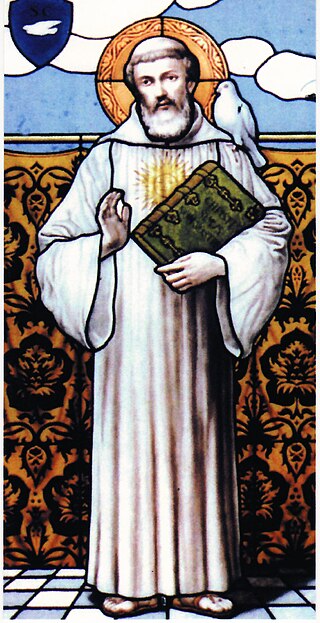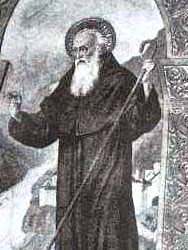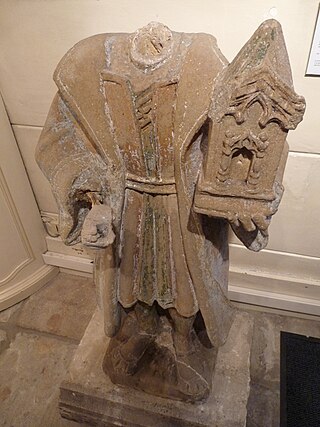Related Research Articles

Columbanus was an Irish missionary notable for founding a number of monasteries after 590 in the Frankish and Lombard kingdoms, most notably Luxeuil Abbey in present-day France and Bobbio Abbey in present-day Italy.

Year 597 (DXCVII) was a common year starting on Tuesday of the Julian calendar. The denomination 597 for this year has been used since the early medieval period, when the Anno Domini calendar era became the prevalent method in Europe for naming years.

Chlothar I, sometime called "the Old", also anglicised as Clotaire, was a king of the Franks of the Merovingian dynasty and one of the four sons of Clovis I.

Childebert II (c.570–596) was the Merovingian king of Austrasia from 575 until his death in March 596, as the only son of Sigebert I and Brunhilda of Austrasia; and the king of Burgundy from 592 to his death, as the adopted son of his uncle Guntram.

Ebroin was the Frankish mayor of the palace of Neustria on two occasions; firstly from 658 to his deposition in 673 and secondly from 675 to his death in 680 or 681. In a violent and despotic career, he strove to impose the authority of Neustria, which was under his control, over Burgundy and Austrasia.

The Kingdom of the Franks, also known as the Frankish Kingdom, the Frankish Empire or Francia, was the largest post-Roman barbarian kingdom in Western Europe. It was ruled by the Frankish Merovingian and Carolingian dynasties during the Early Middle Ages. Francia was among the last surviving Germanic kingdoms from the Migration Period era.

Luxeuil Abbey, the Abbaye Saint-Pierre et Saint-Paul, was one of the oldest and best-known monasteries in Franche-Comté, located in what is now the département of Haute-Saône in Franche-Comté, France.
Waldebert, , was a Frankish count of Guines, Ponthieu and Saint-Pol who became abbot of Luxeuil, and eventually a canonized saint in the Roman Catholic Church and Eastern Orthodox Church. Like several among his kinsmen, he protected the Church, enriched it with lands and founded monasteries. His brother was Faro.
Jonas of Bobbio was a Columbanian monk and a major Latin monastic author of hagiography. His Life of Saint Columbanus is "one of the most influential works of early medieval hagiography."

The Hiberno-Scottish mission was a series of expeditions in the 6th and 7th centuries by Gaelic missionaries originating from Ireland that spread Celtic Christianity in Scotland, Wales, England and Merovingian France. Celtic Christianity spread first within Ireland. Since the 8th and 9th centuries, these early missions were called 'Celtic Christianity'.
Bertulf was the third abbot of the monastery of Bobbio.

Attala or Atala was a disciple of Columbanus and his successor as abbot of Bobbio from 615.
Chagnoald was a Frankish bishop of Laon during the 7th century. The family to which Chagnoald belonged is known as the Faronids, named after his brother Saint Faro, who was bishop of Meaux, while his sister was Saint Burgundofara, who founded the convent of Faremoûtiers. They were the children of the chancellor to Dagobert I, Chagneric.
Gundoin was the first Duke of Alsace in the middle of the seventh century. He was a Frankish nobleman from the Meuse-Moselle basin. He was, according to the author of the Vita Sadalbergae, an "illustrious man, opulent in wealth and fame according to the highest secular dignity and skilled in courtly affairs."

Saint Romaric was a Frankish nobleman who lived in Austrasia from the late 6th century until the middle of the 7th century. He and Amatus of Grenoble founded Remiremont Abbey.
Eustace of Luxeuil, also known as Eustasius, was the second abbot of Luxeuil from 611. He succeeded his teacher Columbanus, to whom he had been a favorite disciple and monk. He had been the head of the monastic school.
Waldalenus, or Wandalenus, dux in the region between the Alps and the Jura, in the Frankish Kingdom of Burgundy, was a Frankish magnate who served as mayor of the Austrasian palace at Metz from 581, during the minority of Childebert II.
There have been several synods of Mâcon, provincial church councils held in the city of Mâcon, then the seat of a diocese.

Moutiers-Saint-Jean Abbey was a monastery located in what is now the village of Moutiers-Saint-Jean in the Côte-d'Or department in eastern France. It is in Burgundy, near Dijon.
Saint Agilus was a Frankish nobleman who became a Christian missionary in Bavaria and later was abbot of Rebais monastery near Paris, France. He was considered a saint, and his feast day is 30 August.